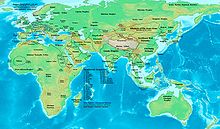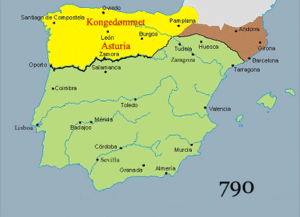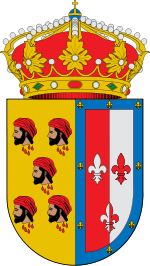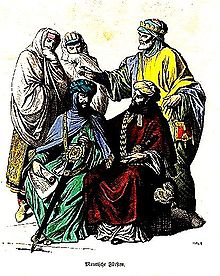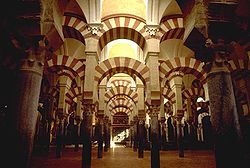- Moors
-
 The Almoravides dynasty, c. 1100 CE. At the dynasty's greatest expanse of control, a succession of Moroccan-based states existed from modern Senegal to the Iberian Peninsula.
The Almoravides dynasty, c. 1100 CE. At the dynasty's greatest expanse of control, a succession of Moroccan-based states existed from modern Senegal to the Iberian Peninsula.
The description Moors has referred to several historic and modern populations of the Maghreb region (Western North Africa) who are predominately of Berber and Arab descent[1] but can also have some Sub-Saharan African, European or Jewish elements. They came to conquer and rule the Iberian Peninsula for nearly 800 years. At that time they were Muslim, although earlier the people had followed other religions. They called the territory Al Andalus, comprising most of what is now Spain and Portugal.
"Moors" are not a distinct or self-defined people. Medieval and early modern Europeans applied the name primarily to Berbers, but also at various times to Arabs and Muslim Iberians.[2] Mainstream scholars observed in 1911 that "The term 'Moors' has no real ethnological value."[3]
The Andalusian Moors of the late Medieval era inhabited the Iberian Peninsula after the Moorish conquests of the Rashidun and Umayyad Caliphates, and the final Umayyad conquest of Hispania.[citation needed] The Moors' rule stretched at times as far as modern-day Mauritania, West African countries, and the Senegal River. Earlier, the Classical Romans interacted with (and later conquered) parts of Mauretania, a state that covered northern portions of modern Morocco and much of north western and central Algeria during the classical period. The people of the region were noted in Classical literature as the Mauri.
The term Mauri, or variations, was later used by European traders and explorers of the 16th to 18th centuries to designate ethnic Berber and Arab groups speaking the Hassaniya Arabic dialect.[citation needed] Today such groups inhabit Mauritania and parts of Algeria, western Sahara, Morocco, Niger and Mali.[4] Speakers of European languages have historically designated a number of associated ethnic groups as "Moors". In modern Iberia, the term is applied to people of Moroccan ethnicity living in Europe. "Moor" is sometimes colloquially applied to any person from North Africa. Some people to whom it is applied consider the term pejorative and racist.
Contents
Etymology
In Latin, the word maurus (plural mauri) means coming from Mauretania, a Roman province on the northwestern fringe of Africa. In the Medieval Romance languages (such as Portuguese, Spanish, French, Italian,Romanian), the root appeared in such forms as mouro, moro, moir, mor and maur. Derivatives are found in today's versions of the languages. Some derive the word from the ancient Greek mauros, meaning "dark".
Through nominalization, the root has taken on a variety of meanings. Moreno, from the Latin root, can mean "tanned" in Spain and Portugal, as well as in Brazil. In Cuba and other Spanish-speaking countries, it can mean "black person" or "mulatto"[citation needed]. Also in Spanish, morapio is a humorous name for "wine", especially that which has not been "baptized" or mixed with water, i.e., pure unadulterated wine. Among Spanish speakers, moro ("Moor") came to have a broader meaning, applied to both Moros of Mindanao in the Philippines, and the moriscos of Granada. Moro is used to describe all things dark, as in "Moor", moreno, etc. It was used as a nickname; for instance, the Milanese Duke Ludovico Sforza was called Il Moro because of his dark complexion. In Polish murzyn means a black person. It can be used either neutrally or pejoratively.
In Portugal and Spain, mouro (feminine, moura) may also refer to supernatural beings known as enchanted moura, where "moor" implies 'alien' and 'non-Christian'; These beings were siren-like fairies with golden or reddish hair and a fair face. They were believed to have magical properties.[5] From this root, the name moor is also applied to unbaptised children, meaning not Christian.[6][7] In Basque, mairu means moor and also refers to a mythical people.[8][dead link]
History
See also: Domain of MoorOverview
Although the Moors came to be identified as Muslim, the name Moor pre-dates Islam. It derives from the small Numidian Kingdom of Maure of the 3rd century BCE in what is now northern central and western part of Algeria and a part of northern Morocco.[9] The name was applied to people of the entire region. "They were called Maurisi by the Greeks", wrote Strabo, "and Mauri by the Romans."[10] During that age, the Maure or Moors were trading partners of Carthage, the independent city state founded by Phoenicians. During the second Punic war between Carthage and Rome, two Moorish Numidian kings took different sides, Syphax with Carthage, Masinissa with the Romans, decisively so at Zama.
Thereafter, the Moors entered into treaties with Rome. King Jugurtha responded to violence against merchants with war. Juba, a later king, was a friend of Rome. Eventually, the Roman Empire incorporated the region as the provinces of Mauretania Caesariensis and Mauretania Tingitana. The area around Carthage was already part of the province of Africa. Roman rule was effective enough so that these provinces became integrated into the empire.
During the Christian era, two prominent Berber churchmen were Tertullian and St. Augustine. After the fall of Rome, the Germanic kingdom of the Vandals ruled much of the area.
Neither Vandal nor Byzantine could extend effective rule; the interior remained under Moorish Berber control.[11] For more than 50 years, the Berbers resisted Arab armies from the east. Among its memorable resistance were the forces led by Kahina, the Berber prophetess of the Awras, during 690–701. By 700 CE, or the 92nd lunar year after the Hijra, the Arab Muslims dominated North Africa.[12]
The Moors of Iberia
In 711 CE, the now Islamic Moors conquered Visigothic Christian Hispania. Their general, Tariq ibn-Ziyad, brought most of Iberia under Islamic rule in an eight-year campaign. They moved northeast across the Pyrenees Mountains, but were defeated by the Frank Charles Martel at the Battle of Poitiers in 732 CE.
The Moorish state fell into civil conflict in the 750s. The Moors ruled in North Africa and in most of the Iberian peninsula for several decades. They were resisted in areas in the northwest (such as Asturias, where they were defeated at the battle of Covadonga) and the largely Basque regions in the Pyrenees. Though the number of Moor colonists was small, many native Iberian inhabitants converted to Islam. According to Ronald Segal, by 1200 CE, some 5.6 million of Iberia's 7 million inhabitants, nearly all native inhabitants, were Muslim.[13] In the late 15th century, the persecution of Muslims and forced conversion to Catholicism caused a mass exodus.
In a process of decline, the Al Andalus had broken up into a number of Islamic-ruled fiefdoms, or taifas, which were partly consolidated under the Caliphate of Córdoba.[citation needed]
The Asturias, a small northwestern Christian Iberian kingdom, initiated the Reconquista (the "reconquest") soon after the Islamic conquest in the 8th century. Christian states based in the north and west slowly extended their power over the rest of Iberia. Navarre, Galicia, León, Portugal, Aragón, Catalonia or Marca Hispanica, and Castile began a process of expansion and internal consolidation during the next several centuries under the flag of Reconquista.
In 1212, a coalition of Christian kings under the leadership of Alfonso VIII of Castile drove the Muslims from Central Iberia. The Portuguese side of the Reconquista ended in 1249 with the conquest of the Algarve (Arabic الغرب — Al-Gharb) under Afonso III. He was the first Portuguese monarch to claim the title "King of Portugal and the Algarve".
The Moorish Kingdom of Granada continued for three more centuries in the southern Iberia. On January 2, 1492, the leader of the last Muslim stronghold in Granada surrendered to armies of a recently united Christian Spain (after the marriage of Ferdinand II of Aragon and Isabella I of Castile, the Catholic Monarchs). They forced the remaining Muslims and Jews to leave Spain, convert to Roman Catholic Christianity or be killed for not doing so. To exert social and religious control, in 1480, Isabella and Ferdinand agreed to allow the Inquisition in Spain.
The Inquisition was aimed mostly at Jews and Muslims who had overtly converted to Christianity but were thought to be practicing their faiths secretly. They were respectively called marranos and moriscos. The Inquisition also attacked heretics who rejected Roman Catholic orthodoxy, including alumbras, who practiced a personal mysticism or spiritualism. The latter represented a significant portion of the peasants in some territories, such as Aragon, Valencia or Andalusia. In the years from 1609 to 1614, the government expelled such subjects. The historian Henri Lapeyre estimated that this affected 300,000 out of an estimated total of 8 million inhabitants.[14]
Many Muslims converted to Christianity and remained permanently in Iberia. This is indicated by a "high mean proportion of ancestry from North African (10.6%)" that "attests to a high level of religious conversion (whether voluntary or enforced), driven by historical episodes of social and religious intolerance, that ultimately led to the integration of descendants.".[15][16]
In the meantime, the tide of Islam had rolled not just to Iberia, but also eastward, through India, the Malayan peninsula, and Indonesia up to the Philippines. This was one of the major islands of an archipelago which the Spaniards had reached during their voyages westward from the New World. By 1521, the ships of Magellan and other Spanish explorers had reached that island archipelago, which they named Las Islas de Filipinas, after Philip II of Spain. In Mindanao, the Spaniards named the kris-bearing people as Moros or 'Moors'. Today in the Philippines, this ethnic group of people in Mindanao, who are generally Muslims, are called 'Moros'. This identification of Islamic people as Moros persists in the modern Spanish language spoken in Spain, and as Mouros in the modern Portuguese language. See Reconquista, and Maure.
According to historian Richard A. Fletcher,[17] 'the number of Arabs who settled in Iberia was very small. "Moorish" Iberia does at least have the merit of reminding us that the bulk of the invaders and settlers were Moors, i.e. Berbers from Algeria and Morocco.'.
Modern age
Beside its usage in historical context, Moor and Moorish (Italian and Spanish: moro, French: maure, Portuguese: mouro) is used to designate an ethnic group speaking the Hassaniya Arabic dialect. They inhabit Mauritania and parts of Algeria, Western Sahara, Tunisia, Morocco, Niger and Mali. In Niger and Mali, these peoples are also known as the Azawagh Arabs, after the Azawagh region of the Sahara.[18]
In Spain, modern colloquial Spanish use of the term "Moro" is derogatory for Moroccans in particular[19][20][21][22][23] and North Africans in general. Similarly, in modern, colloquial Portuguese, the term "Mouro" was primarily used as a designation for North Africans and secondarily as a derogatory and ironic term by northern Portuguese to refer to the inhabitants of the southern parts of the country (Lisbon, Alentejo and Algarve). However, this designation has gotten more acceptance in the South.
In the Philippines, a former Spanish colony, many residents call the local Muslim population in the Southern islands Moros. They also self-identify that way (see Muslim Filipino). The term was introduced by the Spanish colonizers. Within the context of Portuguese colonization, in Sri Lanka (Portuguese Ceylon), Muslims of Arab origin are called Moors (see Sri Lankan Moors).
Religious relations
The rule of the Moors in the Iberian peninsula under this Caliphate of Córdoba is regarded as tolerant in its acceptance of Christians, Muslims and Jews living in the same territories.
Architecture
Moorish architecture is a term used to describe the articulated Islamic architecture of North Africa and parts of Spain and Portugal where the Moors were dominant from 711–1492. The best surviving examples are La Mezquita in Córdoba and the Alhambra palace (mainly 1338–1390),[24] and also the Giralda in 1184.[25] Other notable examples include the ruined palace city of Medina Azahara (936–1010), the church (former mosque) San Cristo de la Luz in Toledo, the Aljafería in Saragossa and baths at for example Ronda and Alhama de Granada.
Heraldry
 Arms of the great Bristol merchant and shipper William II Canynges(d.1474), as depictd on his canopied tomb in St Mary Redcliffe Church, showing the couped heads of three Moors wreathed at the temples, possibly slaves
Arms of the great Bristol merchant and shipper William II Canynges(d.1474), as depictd on his canopied tomb in St Mary Redcliffe Church, showing the couped heads of three Moors wreathed at the temples, possibly slaves
In European heraldry the Moors are shown as black Africans, most frequently as a couped (i.e. severed) head with the temples wreathed.
Population genetics
See also: Berbers#Genetic evidenceShomarka Keita, a biological anthropologist from Howard University, has claimed that populations in Carthage circa 200 BC and northern Algeria 1500 BC were very diverse. As a group, they plotted closest to the populations of Northern Egypt and intermediate to Northern Europeans and tropical Africans. Keita claimed that "the data supported the comments from ancient authors observed by classicists: everything from fair-skinned blonds to peoples who were dark-skinned 'Ethiopian' or part Ethiopian in appearance."[26] Modern evidence showed a similar diversity among present North Africans. Moreover, this "diversity" of phenotypes and peoples was probably due to in situ differentiation, not foreign influxes. Of course foreign influxes certainly had an impact but they did not replace the indigenous Berber population.[27]
The Y chromosome p49a,f TaqI Haplotype V, which corresponds to Y haplogroup E1b1b1b (M81) —formerly E3b1b, E3b2 and colloquially referred to as the "Berber marker"— has been found among 68.9% of modern Berbers in North Africa and as high as 80% in one group. It is believed to be about 5,600 years old,[28] and to have arrived with the Neolithic expansion from the Near East. M81 is not found in Sub-Saharan Africa. This haplotype has also been observed in as high as 40% of one small group of Andalusians tested. Generally it appears at much lower frequencies among Iberian populations, and lower as distance from North Africa increases.[29]
Y DNA haplogroup E1b1b (formerly E3b) predominates among North African populations; its E1b1b1b subgroup (M81) is identified especially with Berbers. The Vb subtype of p49a,f Haplotype V, apparently corresponding to E3b1b, has been found to occur in two-thirds of the Haplotype V Southern Iberians, that is, in about a quarter of all Andalusians tested. The frequency of Vb is at its highest among Berbers, and was found to decline rapidly from West to East among North Africans sampled. It is uncommon in France and Italy.[29]
A 2006 mitochondrial DNA study of 12th to 13th century Islamic remains from Priego de Córdoba, Spain, indicates a higher proportion (4%) of sub-Saharan African lineages. This is attributed only partially to the period of Moorish occupation; researchers believe that more ancient migrations from Africa to Europe were more significant.[30]
“ Mitochondrial DNA sequences and restriction fragment polymorphisms were retrieved from three Islamic 12th to 13th century samples of 71 bones and teeth (with >85% efficiency) from Madinat Baguh (today called Priego de Córdoba, Spain). Compared with 108 saliva samples from the present population of the same area, the medieval samples show a higher proportion of sub-Saharan African lineages that can only partially be attributed to the historic Muslim occupation. In fact, the unique sharing of transition 16175, in L1b lineages, with Europeans, instead of Africans, suggests a more ancient arrival to Europe from Africa. The present-day Priego sample is more similar to the current south Iberian population than to the medieval sample from the same area. The increased gene flow in modern times could be the main cause of this difference. ” Notable Moors
 Aureus of Macrinus. Its elaborate symbolism celebrates the liberalitas ("prodigality") of Macrinus and his son.
Aureus of Macrinus. Its elaborate symbolism celebrates the liberalitas ("prodigality") of Macrinus and his son.
- Lusius Quietus, a Roman general, governor of Iudaea in 117. Originally a Berber prince, his military ability won him the favor of Trajan, who even designated him as his successor. During the emperor's Parthian campaign, the numerous Jewish inhabitants of Babylonia revolted and were relentlessly suppressed by Quietus, who was rewarded by being appointed governor of Judea. Restlessness in the region caused Trajan to send his favorite, as a legate of consular rank, to Judea, where he continued his sanguinary course.
- Macrinus, 164–218, a Berber officer, prefect of the Praetorian Guard under Caracalla. In 217–218, he became the first Roman emperor who was not a senator.
- Gildo, a Berber chieftain who instigated a rebellion against the Roman Empire in 398.
- Tariq ibn Ziyad, Berber general who defeated the Visigoths and conquered Hispania in 711.
- Al-Mansur, reigned 754–775, second Caliph of the Abbasid Caliphate; his mother was a Berber.
- Abd ar-Rahman I, founder of the Umayyad Emirate of Córdoba in 756; along with its succeeding Caliphate of Córdoba, the dynasty ruled Islamic Spain for three centuries.
- Abbas Ibn Firnas, 810–887, Berber inventor and aviator who invented an early parachute and made the first attempt at controlled flight with a hang glider.
- Maslamah Ibn Ahmad al-Majriti, died 1007, Andalusian writer believed to have been the author of the Encyclopedia of the Brethren of Purity and the Picatrix.
- Abu al-Qasim al-Zahrawi (Abulcasis), Andalusian physician and surgeon who established the discipline of surgery as a profession with his Al-Tasrif in 1000.
- Abū Ishāq Ibrāhīm al-Zarqālī (Arzachel), 1028–1087, Andalusian astronomer and engineer who developed the equatorium and universal (latitude-independent) astrolabe and compiled a Zij later used as a basis for the Tables of Toledo.
- Ibn Bajjah (Avempace), died 1138, Andalusian physicist and polymath whose theory of motion, including the concept of a reaction force, influenced the development of classical mechanics.
- Ibn Zuhr (Avenzoar), 1091–1161, Andalusian physician and polymath who discovered the existence of parasites and pioneered experimental surgery.
- Muhammad al-Idrisi, circa 1100–1166, Moorish geographer and polymath who drew the Tabula Rogeriana, the most accurate world map in pre-modern times.
- Ibn Tufail, circa 1105–1185, Arabic writer and polymath who wrote Hayy ibn Yaqdhan, the first philosophical novel.
- Ibn Rushd (Averroes), 1126–1198, classical Islamic philosopher and polymath who wrote The Incoherence of the Incoherence and the most extensive Aristotelian commentaries, and established the school of Averroism.
- Ibn al-Baitar, died 1248, Andalusian botanist and pharmacist who compiled the most extensive pharmacopoeia and botanical compilation in pre-modern times.
- Ibn Battuta, 1304–1368, a Berber traveller who was the most prolific explorer in pre-modern times, travelling 73,000 miles across much of the Old World.
- Ibn Khaldun, a pioneer of the social sciences and forerunner of sociology, historiography and economics, who wrote the Muqaddimah in 1377.
- Abū al-Hasan ibn Alī al-Qalasādī, 1412–1486, Moorish mathematician who took the first steps toward the introduction of algebraic symbolism.
- Othello, the fictitious hero in the eponymous play by William Shakespeare, published in 1604. The character of Othello was a mercenary who served in the war between Venice and the Ottoman Empire, who married the daughter of a Venetian nobleman.
- Estevanico, also referred to as "Stephen the Moor", was an explorer in the service of Spain of what is now the southwest of the United States.
- Monostatos, a fictional corrupt henchman in Mozart's The Magic Flute.
Bibliography
- This section's bibliographical information is not fully provided. If you know these sources and can provide full information, you can help Wikipedia by completing it.
- Jan Carew, Rape of Paradise
- David Brion Davis, "Slavery: Black, White, Muslim, Christian"
- Herodotus, The Histories
- Shomark O.Y. Keita, "Genetic Haplotyes in North Africa"
- Shomark O.Y. Keita, "Craniometric Data from North Africa
- Shomark O.Y. Keita, "Further Craniometric Data from North Africa"
- Shomark O.Y. Keita, "Bernal vs. Snowden"
- Bernard Lewis, "The Middle East"
- Bernard Lewis, "The Muslim Discovery of Europe"
- Bernard Lewis, "Race and Slavery in Islam"
- Stanley Lane-Poole, Turkey (1888)
- Stanley Lane-Poole, The Barbary Corsairs (1890)
- Stanley Lane-Poole, The History of the Moors in Spain
- J.A. Rogers, Nature Knows no Color Line
- Ronald Segal, "Islam's Black Slaves"
- Ivan van Sertima, The Golden Age of the Moor
- Frank Snowdon, "Before Color Prejudice"
- Frank Snowdon, "Blacks in Antiquity"
- David M. Goldenberg, "The Curse of Ham"
- Lucotte and Mercier, various genetic studies
- Eva Borreguero. "The Moors Are Coming, the Moors Are Coming! Encounters with Muslims in Contemporary Spain". Islam and Christian-Muslim relations, 2006, vol. 17, no4, pp. 417–432. Center for Muslim-Christian Understanding, Georgetown University, Washington, D.C.
- "The Moors" by Ross Brann, published on New York University website.
See also
References
- ^ "Moor". Encyclopædia Britannica. http://www.britannica.com/EBchecked/topic/391449/Moor. Retrieved 9 November 2011.
- ^ Ross Brann, "The Moors?", Andalusia, New York University. Quote: "Andalusi Arabic sources, as opposed to later Mudéjar and Morisco sources in Aljamiado and medieval Spanish texts, neither refer to individuals as Moors nor recognize any such group, community or culture."
- ^ "Moors", Britannica Encyclopedia (1911), p. 811
- ^ Online Etymology Dictionary
- ^ Xosé Manuel González Reboredo, Leyendas Gallegas de Tradición Oral (Galician Legends of the Oral Tradition), Galicia: Editorial Galaxia, 2004, p. 18, Googlebooks, accessed 12 Jul 2010 (Spanish)
- ^ Rodney Gallop, Portugal: A Book of Folkways, Cambridge University Press (CUP), 1936; reprint CUP Archives, 1961, Googlebooks, accessed 12 Jul 2010
- ^ Francisco Martins Sarmento, "A Mourama", in Revista de Guimaraes, No. 100, 1990, Centro de Estudos de Património, Universidade do Minho, accessed 12 Jul 2010 (Portuguese)
- ^ Euskadi.net (Spanish)
- ^ Michael Brett and Elizabeth Fentress, The Berbers at 25 & 77; Gabriel Camps, Les Berbères (Edisud 1996) at 20–21, 25
- ^ Strabo, Geographica (c.17 CE.) at XVIII,3,ii (cited by Rene Basset in Moorish Literature (N.Y., Collier 1901) at iii.
- ^ Jamil M. Abun-Nasr, A History of the Maghrib (Cambridge Univ., 1971) at 27, 38 & 43; Michael Brett and Elizabeth Fentress, The Berbers (Blackwell 1996) at 14, 24, 41–54; Henri Terrasse, History of Morocco (Casablanca: Atlantides 1952) at 39–49, esp. 43–44; Serge Lancel, Carthage (Librairie Artheme Fayard 1992, Blackwell 1995) at 396–401; Glenn Markoe, The Phoenicians, Berkeley, CA: Univ. of California, 2000, pp. 54–56
- ^ "The conquest of North Africa and Berber resistance" in General History of Africa
- ^ Ronald Segal, Islam's Black Slaves (2003), Atlantic Books, ISBN 1-90380981-9
- ^ See History of Al-Andalus
- ^ Adams et al., "The Genetic Legacy of Religious Diversity and Intolerance: Paternal Lineages of Christians, Jews, and Muslims in the Iberian Peninsula", Cell, 2008. Quote: "Admixture analysis based on binary and Y-STR haplotypes indicates a high mean proportion of ancestry from North African (10.6%) ranging from zero in Gascony to 21.7% in Northwest Castile."
- ^ Elena Bosch, "The religious conversions of Jews and Muslims have had a profound impact on the population of the Iberian Peninsula", University of , 2008, Quote: "The study shows that religious conversions and the subsequent marriages between people of different lineage had a relevant impact on modern populations both in Spain, especially in the Balearic Islands, and in Portugal."
- ^ Richard Fletcher. Moorish Spain p10. University of California Press. 1993. ISBN 978-0520084964
- ^ For an introduction to the culture of the Azawagh Arabs, see: Rebecca Popenoe, Feeding Desire — Fatness, Beauty and Sexuality among a Saharan People. Routledge, London (2003) ISBN 0415280966
- ^ Simms, Karl (1997). Translating sensitive texts: linguistic aspects. Rodopi. pp. 144. ISBN 9789042002609. http://books.google.com/books?id=t4y7EHgCn8kC&pg=PA1&lpg=PA1&dq#v=onepage&q&f=false.
- ^ Warwick Armstrong, James Anderson (2007). Geopolitics of European Union enlargement: the fortress empire. Routledge. pp. 83. ISBN 9780415339391. http://books.google.com/books?id=0pmkrY29qkIC&dq.
- ^ Wessendorf, Susanne (2010). The multiculturalism backlash: European discourses, policies and practices. Taylor & Francis. pp. 171. ISBN 9780415556491. http://books.google.com/books?id=wUaHVimJkT0C&dq.
- ^ Tariq Modood, Anna Triandafyllidou, Ricard Zapata-Barrero (2006). Multiculturalism, Muslims and citizenship: a European approach. Routledge. pp. 143. ISBN 9780415355155. http://books.google.com/books?id=7OAAV5eEmy4C&dq.
- ^ Bekers, Elisabeth (2009). Transcultural modernities: narrating Africa in Europe. Rodopi. pp. 14. ISBN 9789042025387. http://books.google.com/books?id=N4_on188WJwC&dq.
- ^ Curl p.502
- ^ Pevsner — The penguin dictionary of architecture
- ^ G. Mokhtar."General History of Africa: Ancient Civilizations of Africa", pg 427
- ^ "Studies of ancient crania from northern Africa", AMERICAN JOURNAL OF PHYSICAL ANTHROPOLOGY 83:35-48 (1990)
- ^ Arredi et al. (2004), A Predominantly Neolithic Origin for Y-Chromosomal DNA Variation in North Africa, Am J Hum Genet. 2004 August; 75(2): 338–345.
- ^ a b Nathalie Gérard et al., "North African Berber and Arab Influences in the Western Mediterranean Revealed by Y-Chromosome DNA Haplotypes", Human Biology, Volume 78, Number 3, June 2006, pp. 307–316.
- ^ Biologisk institutt
External links
- Moorsgate.com
- Pbs.org
- Encyclopedia - Britannica Online Encyclopedia (2006)
- Moors, Classic Encyclopedia (1911)
- Khalid Amine, Moroccan Shakespeare: From Moors to Moroccans. Paper presented at an International Conference Organized by The Postgraduate School of Critical Theory and Cultural Studies, University of Nottingham, and The British Council, Morocco, 12–14 April 2001.
- Heraldry: The Moor's Head, Hidden Histories - African in Medieval and Renaissance Art, Victoria and Albert Museum (n.d)
- Sean Cavazos-Kottke. Othello's Predecessors: Moors in Renaissance Popular Literature: (outline). Folger Shakespeare Library, 1998.
Tribal hegemony in the former Western Roman Empire from the decline of Rome to 843 Huns 376–454 • Vandals 406–475 • Visigoths 410–711 • Franks 509–843 • Ostrogoths 493–553 • Byzantines 553–568 • Lombards 568–774 • Moors 711–1492
Wikimedia Foundation. 2010.


